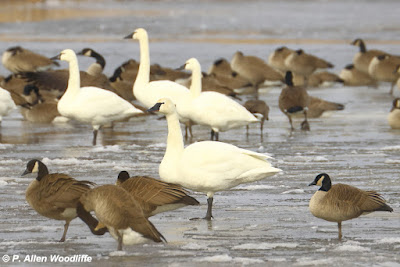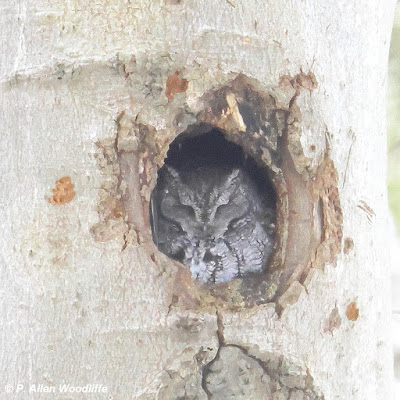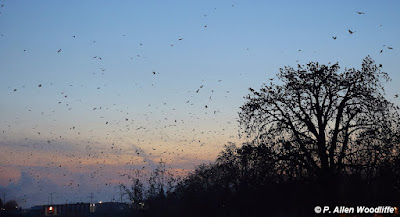Birding has definitely quietened down, which is typical for the mid-winter period. There are a few lingering species, but most of what is around are fairly typical wintering species. Getting out and about does provide a few photo opportunities, however.
There is still a good number of geese and even swans around, and as long as there is a bit of open water and not too much snow on the fields, I expect that trend to continue. In checking out some of the flocks of geese and swans, one comes across an occasional less expected lingering species. Such was the case when I was checking out the waterfowl at St. Clair NWA recently. After scanning a lot of birds, I came across this Snow Goose. Fortunately it was even on the closest side of the flock making this quite clear photo relatively easy.
As expected, there was a mix of geese and swans.
A closer look at the flock had the bird in the lower right hand side of the photo get my attention. It was a little smaller than the usual Canada Geese, and the bill was a bit smaller as well. At first I was considering Cackling Goose, but it didn't look quite small enough, and the bill looked a bit too large for a typical Cackler. Also the upper chest was light coloured, rather than the darker colour of a typical Cackling Goose. There are many races and sizes in the Canada Goose complex, and I ultimately decided it could be a Richardson's Canada Goose.There had been quite a few Bald Eagles, up to 40 individuals, reported from the same general wetland complex along Lake St. Clair. That is a notable number, but not entirely unexpected. A couple of years ago on the SCNWA Christmas Bird Count, we tallied at least 58 birds, and there could have been more. In fact there were more reported by all of the observers that day, but I suspected there was some double counting since they are a large bird that would have potentially crossed into more than one observer's territory, so downgraded the total to a mere 58. That was a record for that CBC, and almost unheard of anywhere in Ontario. However eagles migrate here to the southwest, and since there were still lots of waterfowl around to feed on, especially with the ongoing hunting season that might have resulted in crippled ducks and geese, the eagles would likely take advantage of it. And why not if the food is there for the taking.
In some years, Lake St. Clair is almost completely frozen over, and any eagles that persist this far into the winter are scattered far and wide across the ice and along the lake shore areas. With no ice to rest on, and still a fair bit of food to partake of, they are more likely to be found along the shoreline areas.
Since the large number of eagles reported were on an extensive private marsh, I didn't try and attempt to see them. However I did travel to the Jeanette's Creek boat launch area, which provides a good look upstream and downstream along the Thames River, and I have regularly seen a few eagles there. On this occasion when I checked it out, I saw at least a dozen, and since some were on the move a bit, there were likely more. Especially since a lot of the riverine habitat was upstream from where I was able to see, and certainly much closer to where the aforementioned 40 birds were reported.
I managed to get a few photos, but most were quite a distance away, and so were difficult to get good shots of without a lot of cropping of the photos. Some young birds were cavorting in the sky, practicing for when they got old enough to attract a mate or defending a territory. Or maybe they were just enjoying the wonder of flight.
And sometimes this was about the only view.
When I wasn't looking for eagles, I saw and photographed some of the 5 Great Blue Herons that were scattered along the river edge.
This Northern Harrier came upon me quite suddenly, and I was unprepared with the proper camera settings, so this is the best I could do.
I have been out to Rondeau on occasion (big surprise!), primarily to go for a good walk and photograph a few things that I will deal with in a future post. The woods are fairly quiet this time of year but I still marvel at the forest complex as I walk along. I have managed to see one of the resident Eastern Screech Owls on occasion....
...and a few Northern Cardinals here and there.Yesterday I purposely stopped by the Blenheim Sewage Lagoons, hoping to see a Ross's Goose that appears either there or in the Erieau area on occasion. There were no geese in the lagoons themselves, but a couple of Mute Swans gave a good photo opportunity. I had to photograph something to show for my time there.....:-)
...and then I realized that there were several hundred geese out on a wheat field adjacent to the lagoons, so drove around to check them out. I wasn't certain I would be able to find a small white goose if it was a long way out on a snow-covered field, but fortunately it was in one of the closer groups of geese.It was still probably 250-300 metres from the road, so only got a distant and highly cropped shot, but good enough for identification purposes.
If you want to subscribe, or unsubscribe, to Nature Nuggets, send an email to: prairietramper@gmail.com































































